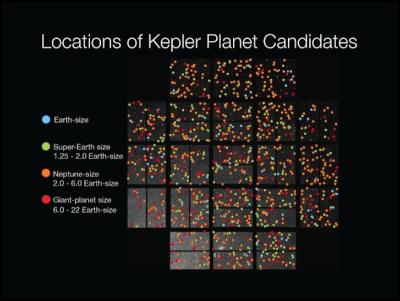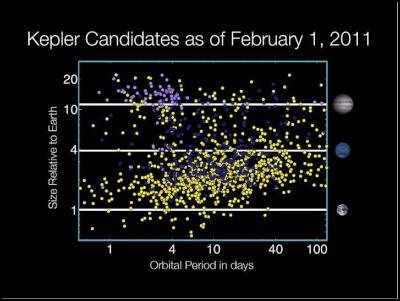NASA Finds Earth-size Planet Candidates in Habitable Zone
[Original story with links: http://www.nasa.gov/mission_pages/kepler/news/kepler_data_release.html]
NASA Finds Earth-size Planet Candidates in the Habitable Zone
02.02.11
Kepler's planet candidates by size.
Image credit: NASA/Wendy Stenzel
Is our Milky Way galaxy home to other planets the size of Earth? Are Earth-sized planets common or rare? NASA scientists seeking answers to those questions recently revealed their discovery.
"We went from zero to 68 Earth-sized planet candidates and zero to 54 candidates in the habitable zone - a region where liquid water could exist on a planet’s surface. Some candidates could even have moons with liquid water," said William Borucki of NASA’s Ames Research Center, Moffett Field, Calif., and the Kepler Mission’s science principal investigator. "Five of the planetary candidates are both near Earth-size and orbit in the habitable zone of their parent stars."
Planet candidates require follow-up observations to verify they are actual planets.

Kepler's planet candidates as of Feb. 1, 2011.
Image credit: NASA/Wendy Stenzel
"We have found over twelve hundred candidate planets - that’s more than all the people have found so far in history," said Borucki. "Now, these are candidates, but most of them, I’m convinced, will be confirmed as planets in the coming months and years."
The findings increase the number of planet candidates identified by Kepler to-date to 1,235. Of these, 68 are approximately Earth-size; 288 are super-Earth-size; 662 are Neptune-size; 165 are the size of Jupiter and 19 are larger than Jupiter. Of the 54 new planet candidates found in the habitable zone, five are near Earth-sized. The remaining 49 habitable zone candidates range from super-Earth size -- up to twice the size of Earth -- to larger than Jupiter. The findings are based on the results of observations conducted May 12 to Sept. 17, 2009 of more than 156,000 stars in Kepler’s field of view, which covers approximately 1/400 of the sky.
"The fact that we’ve found so many planet candidates in such a tiny fraction of the sky suggests there are countless planets orbiting stars like our sun in our galaxy," said Borucki. "Kepler can find only a small fraction of the planets around the stars it looks at because the orbits aren’t aligned properly. If you account for those two factors, our results indicate there must be millions of planets orbiting the stars that surround our sun."
“We’re about half-way through Kepler’s scheduled mission," said Roger Hunter, the Kepler project manager. "Today’s announcement is very exciting and portends many discoveries to come. It’s looking like the galaxy may be littered with many planets.”
Among the stars with planetary candidates, 170 show evidence of multiple planetary candidates, including one, Kepler-11, that scientists have been able to confirm that has no fewer than six planets.
"Another exciting discovery has been the tremendous variations in the structure of the confirmed planets – some have the density of Styrofoam and others are denser than iron. The Earth's density is in between."
"The historic milestones Kepler makes with each new discovery will determine the course of every exoplanet mission to follow," said Douglas Hudgins, Kepler program scientist at NASA Headquarters in Washington.
Kepler, a space telescope, looks for planet signatures by measuring tiny decreases in the brightness of stars caused by planets crossing in front of them - this is known as a transit.
Since transits of planets in the habitable zone of sun-like stars occur about once a year and require three transits for verification, it is expected to take three years to locate and verify Earth-size planets orbiting sun-like stars.
The Kepler science team uses ground-based telescope and the Spitzer Space Telescope to perform follow-up observations on planetary candidates and other objects of interest found with the spacecraft. The star field that Kepler observes in the constellations Cygnus and Lyra can only be seen from ground-based observatories in spring through early fall. The data from these other observations helps determine which of the candidates can be validated as planets.
"The first four months of data have given us an enormous amount of interesting information for the science community to explore and to find the planets among the candidates that we have found," said Borucki. "Keep in mind, in the future, we’ll have even more data for small planets in and near the habitable zone for everyone to look at."
Kepler will continue conducting science operations until at least November 2012, searching for planets as small as Earth, including those that orbit stars in a warm habitable zone where liquid water could exist on the surface of the planet. Since transits of planets in the habitable zone of solar-like stars occur about once a year and require three transits for verification, it is expected to take three years to locate and verify Earth-size planets orbiting sun-like stars.
Borucki predicted that the search using the Kepler spacecraft’s continuous and long-duration capability will significantly enhance scientists’ ability to determine the distributions of planet size and orbital period in the future.
"In the coming years, Kepler’s capabilities will allow us to find Earth-size planets in the habitable zone of other stars," Borucki said. "Future missions will be developed to study the composition of planetary atmospheres to determine if they are compatible with the presence of life. The design for these missions depends of Kepler finding whether Earth-size planets in the habitable zone are common or rare."
The Kepler Mission team has discovered a total of 15 exoplanets, including the smallest known exoplanet, Kepler-10b.
"Kepler is providing data 100 times better than anyone has ever done before," said Borucki. "It’s exploring a new part of phase space, a new part of the universe that could not be explored without this kind of precision, so it’s producing absolutely beautiful data. We’re seeing the variability of stars like no one has ever seen before. We’re finding planets smaller than anyone has ever seen before, because the data quality is extremely good."
"In one generation we have gone from extraterrestrial planets being a mainstay of science fiction, to the present, where Kepler has helped turn science fiction into today's reality," said NASA Administrator Charles Bolden. "These discoveries underscore the importance of NASA's science missions, which consistently increase understanding of our place in the cosmos."
Kepler is NASA's tenth Discovery mission. Ames is responsible for the ground system development, mission operations and science data analysis. NASA's Jet Propulsion Laboratory, Pasadena, Calif., managed the Kepler mission development. Ball Aerospace and Technologies Corp., Boulder, Colo., was responsible for developing the Kepler flight system, and along with the Laboratory for Atmospheric and Space Physics at the University of Colorado, is supporting mission operations. Ground observations necessary to confirm the discoveries were conducted at the Keck I in Hawaii; Hobby-Ebberly and Harlan J. Smith 2.7m in Texas; Hale and Shane in California; WIYN, MMT and Tillinghast in Arizona, and the Nordic Optical in the Canary Islands, Spain.
ENDS


 John Mazenier: Gaffer Tape And Glue Delivering New Zealand’s Mission Critical Services
John Mazenier: Gaffer Tape And Glue Delivering New Zealand’s Mission Critical Services Earthquake Commission: Ivan Skinner Award Winner Inspired By Real-life Earthquake Experience
Earthquake Commission: Ivan Skinner Award Winner Inspired By Real-life Earthquake Experience Reserve Bank: Consultation Opens On A Digital Currency For New Zealand
Reserve Bank: Consultation Opens On A Digital Currency For New Zealand NIWA: Ship Anchors May Cause Extensive And Long-lasting Damage To The Seafloor, According To New Research
NIWA: Ship Anchors May Cause Extensive And Long-lasting Damage To The Seafloor, According To New Research New Zealand Customs Service: A Step Forward For Simpler Trade Between New Zealand And Singapore
New Zealand Customs Service: A Step Forward For Simpler Trade Between New Zealand And Singapore Horizon Research: 68% Say Make Banks Offer Fraud Protection
Horizon Research: 68% Say Make Banks Offer Fraud Protection



